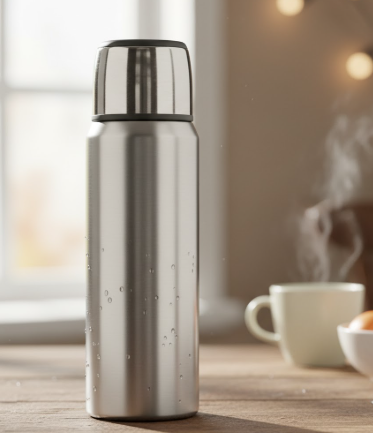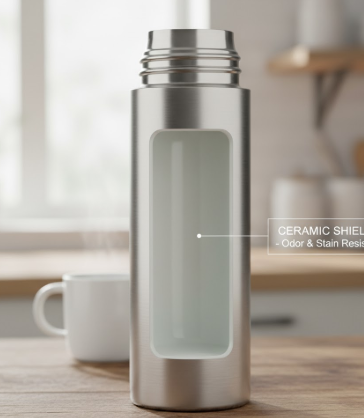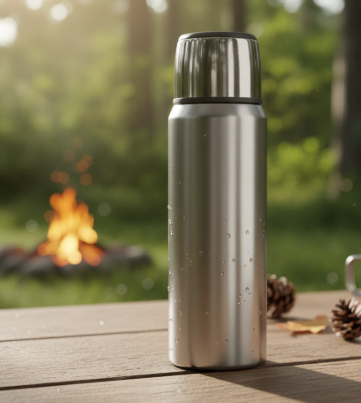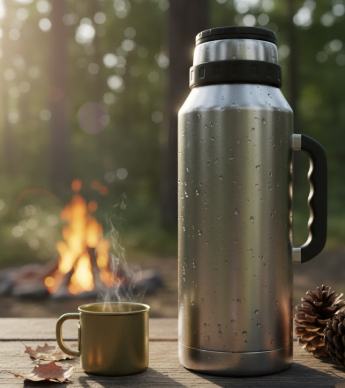How Does a Vacuum Flask Keep Liquids Hot?
Release time:2025-10-21
A vacuum flask is a modern marvel of design that keeps liquids at their ideal temperature for hours. Whether it’s hot coffee, tea, or soup, vacuum flasks are essential for maintaining the desired temperature. But how do they work? And what role does ceramic coating play in improving their performance? In this article, we’ll explore the science behind vacuum flasks, the advantages of ceramic coatings, and help you choose the best vacuum flask for your needs.
What is a vacuum flask?
-How does a vacuum flask work?
-What is the working principle of a vacuum flask?
Ceramic Coating in Vacuum Flasks
-What is Ceramic Coating?
-Can ceramic coating withstand high heat?
-Benefits of Ceramic Coating in Vacuum Flasks
Choosing the Right Vacuum Flask with Ceramic Coating
-Ceramic lined water bottle vs stainless steel
-Best ceramic coated water bottles vs glass lined water bottles
SPCERA Glass to Metal Seal Manufacturers : Best vacuum sealed glass for thermos cups
FAQs
-What is the best heat-resistant ceramic coating?
-Does thermos have a vacuum seal?
-Is ceramic coating safer than stainless steel?
What is a Vacuum Flask?

A vacuum flask, commonly known as a thermos, is a container designed to keep liquids hot or cold for extended periods. It consists of two layers of material—usually stainless steel—surrounding a vacuum-sealed space. This design minimizes heat transfer and helps preserve the temperature of the liquid inside.
How Does a Vacuum Flask Work?
The key to a vacuum flask's effectiveness lies in its double-walled construction. Between the inner and outer layers, there is a vacuum, which means there is no air or matter to transfer heat via conduction or convection. The vacuum acts as an insulator, preventing heat from escaping the flask, thus keeping hot liquids warm and cold liquids cool.
What is the Working Principle of a Vacuum Flask?
The working principle of a vacuum flask is simple but ingenious. Heat naturally moves from warmer areas to cooler ones through three primary methods: conduction, convection, and radiation. A vacuum flask combats all these methods in the following ways:
1.Conduction: The vacuum between the inner and outer layers prevents heat transfer via conduction since there is no material for heat to travel through.
2.Convection: The vacuum also stops air from circulating inside the flask, which would otherwise carry heat away.
3.Radiation: The inner surface of most vacuum flasks is coated with a reflective layer (often silver), which reflects heat back into the liquid, reducing the amount of heat lost through radiation.
By addressing all three methods of heat transfer, a vacuum flask can effectively maintain the temperature of its contents for hours.
Ceramic Coating in Vacuum Flasks

While the vacuum technology inside a flask is crucial for insulation, the addition of ceramic coating enhances the overall performance and usability of vacuum flasks. Ceramic coatings have become increasingly popular for their durability, heat resistance, and health benefits.
What is Ceramic Coating?
Ceramic coating is a layer of inorganic, non-metallic material (usually made from silica and other compounds) applied to the inner surface of a vacuum flask. It’s known for being non-reactive, smooth, and scratch-resistant. Unlike traditional coatings like stainless steel, ceramic doesn’t impart any metallic taste to the liquids inside, making it ideal for beverages such as coffee and tea.
Can Ceramic Coating Withstand High Heat?
Yes, ceramic coatings are designed to withstand high temperatures. They have a high heat tolerance and are capable of maintaining their structural integrity even under the influence of extreme heat. This is particularly important in vacuum flasks that are used to store hot liquids for hours, as ceramic-coated flasks will not break down or degrade when exposed to high temperatures over time.
Benefits of Ceramic Coating in Vacuum Flasks
1.Improved Heat Retention:
Ceramic coatings offer additional insulation by preventing heat transfer between the liquid and the flask's walls. This helps keep your beverage hotter for longer.
2.Better Taste Preservation:
Unlike stainless steel or plastic-lined bottles, ceramic-coated flasks do not leach any metallic or plastic tastes into the liquid. This results in a purer taste for beverages like coffee, tea, or water.
3.Durability:
Ceramic-coated surfaces are highly resistant to scratches and wear, which helps protect the inner walls of the flask from damage. This ensures that the flask remains functional and aesthetically appealing for longer.
4.Non-toxic and Safe:
Ceramic coatings are non-toxic and do not release harmful chemicals, making them a safer choice for storing beverages. They are also hypoallergenic, making them ideal for individuals with sensitive skin or allergies.
5.Eco-friendly:
Ceramic coatings are often more sustainable compared to synthetic alternatives. The materials used are naturally sourced and can be more environmentally friendly than other non-stick coatings, which may contain harmful chemicals.
Choosing the Right Vacuum Flask with Ceramic Coating

When choosing the right vacuum flask with ceramic coating, there are several factors to consider. Ceramic-coated flasks are known for their durability and temperature retention, but it’s essential to weigh other features like size, weight, and design.
Ceramic Lined Water Bottle vs Stainless Steel
While both ceramic-lined water bottles and stainless steel options are great for keeping liquids hot or cold, there are distinct differences:
Ceramic-lined bottles tend to offer a smoother, more natural taste experience since they don’t impart any metallic flavor to the liquid.
Stainless steel bottles are incredibly durable and effective at insulating temperature, but they may sometimes impart a metallic taste, especially with hot liquids.
For those who are concerned about taste and prefer a more natural drinking experience, a ceramic-lined water bottle may be the better choice. On the other hand, if you need something highly durable and rugged, a stainless steel option may be more suitable.
Best Ceramic Coated Water Bottles vs Glass Lined Water Bottles
Ceramic-coated bottles offer a durable, easy-to-clean surface and help prevent any metallic or plastic taste. They also retain heat well and are often more eco-friendly.
Glass-lined bottles offer excellent taste preservation, especially for beverages like tea or coffee, since glass is non-reactive. However, glass can be more prone to breakage and may not be as durable for everyday use.
Ultimately, the choice between ceramic-coated and glass-lined water bottles depends on your personal preferences and lifestyle. Ceramic bottles tend to be more durable and convenient for active users, while glass-lined bottles are best for those who prioritize taste over portability.
SPCERA Glass to Metal Seal Manufacturers: Best Vacuum Sealed Glass for Thermos Cups

For those looking for high-quality, vacuum-sealed thermos cups with advanced glass-to-metal sealing technology, SPCERA manufacturers provide some of the best products on the market. SPCERA's glass-to-metal seals ensure an airtight and leakproof design, offering enhanced durability and heat retention for your thermos cups.
Their products are known for maintaining the integrity of the vacuum seal and for their ability to withstand high temperatures, making them an excellent choice for keeping liquids hot or cold for hours.
Vacuum flasks, with their innovative insulation technology and ceramic coatings, provide an excellent way to keep liquids hot or cold for extended periods. By understanding how vacuum flasks work and the benefits of ceramic coating, you can make an informed choice when selecting the best flask for your needs. Whether you prefer ceramic-lined or stainless steel, the right flask will ensure that your beverages stay at the perfect temperature for hours, all while offering superior durability and taste preservation.
FAQs
What is the best heat-resistant ceramic coating?
The best heat-resistant ceramic coatings are those that are made from high-quality inorganic materials, such as silica or alumina. These coatings are designed to withstand extreme temperatures and are commonly used in vacuum flasks to improve heat retention and durability.
Does thermos have a vacuum seal?
Yes, thermos flasks use a vacuum seal between two walls of stainless steel or another material. The vacuum prevents heat from escaping, keeping your beverages at their desired temperature for an extended period.
Is ceramic coating safer than stainless steel?
Yes, ceramic coatings are generally considered safer than stainless steel in terms of taste preservation and non-toxicity. While stainless steel is durable, it can sometimes leach a metallic taste into the liquid. Ceramic coatings, on the other hand, do not impart any flavors and are hypoallergenic, making them a safer choice for those sensitive to materials.






